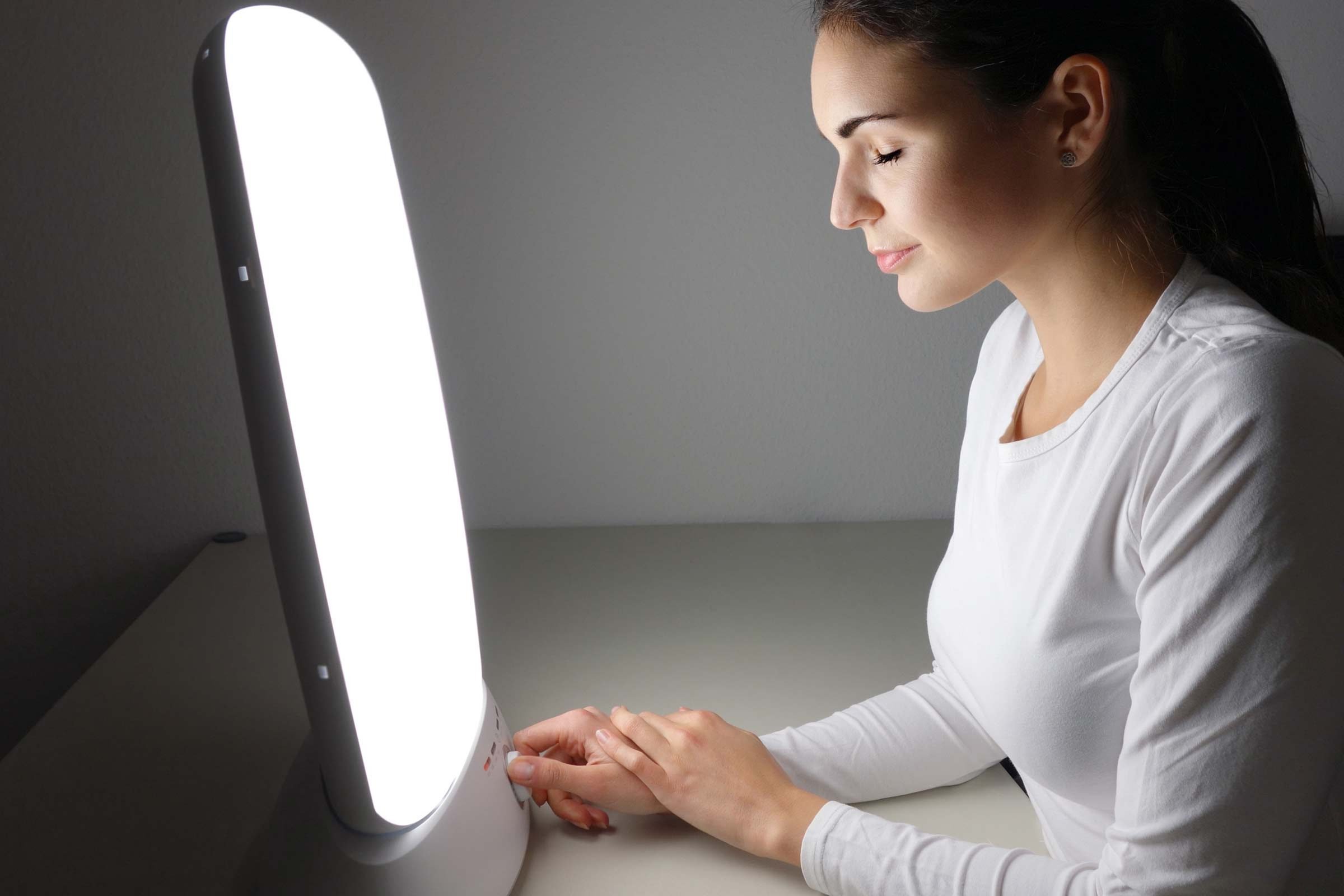Whether you are thinking or have already bought a light therapy lamp, you might wonder about this bright light box’s usage and benefits in boosting dopamine levels.
Seasonal affective disorder is associated with low mood and lack of energy. SAD symptoms are primarily visible in the cooler months, starting to appear in late fall or early winter. Winter blues are more common with people experiencing a mood shift and serotonin deficiency when the days are shorter and there’s less sunlight.
With the appearance of light therapy, such problems may be a thing of the past. Let’s see how to use a light therapy lamp to help fight feeling SAD and improve your circadian rhythm.
Source: magasinetliv.dk
How to Use a Light Therapy Lamp
Even the best RTL lamps won’t help you get results if you don’t use them correctly. Here are the steps you should follow:
Choose the right timings and duration
The first step is to choose the right timings and duration, depending on your daily schedule and requirements. If you can find the time, we recommend using the light therapy lamp in the morning and within the first hour of waking up.
You can use it while catching up on yesterday’s emails or while eating breakfast. Or simply enjoy a distraction-free time and be alone with your thoughts while letting the bright lightbox do its job.
As far as the duration is concerned, you can choose any period between 30-60 minutes.
Place the lamp correctly
The lamp’s position will play an important role, so you should place it correctly. Generally, a 10,000 lux lamp should be kept about two feet away from your body/eyes. However, if your lamp is weak, you can reduce the distance.
You will also have to choose the correct angle. You shouldn’t keep the lamp in front of your eyes and avoid staring at the light. It’s best to keep it about 45 degrees to your left or right.
Consistency is key
You are unlikely to notice a significant difference in your mood and energy levels in a single day. You will have to use it regularly for some time to get results. Daily use from fall to winter may be the best time for the light’s usage.
Combine it with exercise, yoga, and other effective options
Yoga, exercise, and other outdoor activities can also help you improve your mood and energy levels. Combining them with light therapy may help you get better results.
Keep monitoring
You should keep monitoring your mood and energy levels to see if your current routine provides any results. You should make changes if you don’t notice any significant improvement after 2-4 weeks. Increasing the duration, changing your diet, and exercising more often might do the trick.
Why Light Therapy Lamp Is Used
The most common reason for this type of therapy is Seasonal Affective Disorder (SAD), which occurs during the fall and winter months. SAD occurs due to the reduced sunny shorter days. The following symptoms may be linked to this condition:
- Increased fatigue and decreased energy
- Concentration problems
- Changes in appetite and increased desire for carbohydrates
- Feelings of guilt and worthlessness
- Change in sleep (increased sleep)
- Fun speech and movement
But a light therapy lamp won’t solve all your problems. If you feel an internal turmoil, speak to a professional. This therapy is often used to help promote better health and increase serotonin levels.
How Does a Light Therapy Lamp Work
So, how to use a light therapy lamp? Such lightboxes are designed to mimic daylight. When you decide to purchase, you will notice different types of therapy lamps. Choosing a suitable lamp for this type of therapy depends on the person and his health condition.
How is the intensity of light measured in this type of therapy?
The light emitted by such lamps is measured in lux. This measure represents the ratio of light intensity to the surface. Therefore, a light therapy lamp should offer light worth 10,000 lux. Also, the light source is placed above the eyes at an oblique angle to reduce glare.
Things To Look Out For When Using a Light Therapy Lamp
The purpose of the light therapy lamp
Before purchasing your lamp, make sure that you have purchased a lamp designed for seasonal affective disorder. Various lights on the market are used for supposedly treating skin diseases that may not be suitable for solving your problem. In addition, such lamps emit UV light that might harm your eyes.
Amount of light
As mentioned earlier, the function of such lamps is to mimic daylight. Therefore, the amount of light emitted by the lamp is significant. You will find different lamps that emit different amounts of light in the market. 10000 lux is recommended as standard. If you opt for a lamp that emits stronger light, you should reduce the duration of therapy.
Ultraviolet light
The very design of light therapy lamps is to filter UV rays. This means that this type of light must not adversely affect vision.
If in doubt about the amount of UV light, contact the manufacturer, who will explain the details of the lamp itself.
Choosing the right design
Proper design is crucial and depends on the dynamics of your life. If you are constantly on the move, it is best to get a smaller easy-to-carry lamp that does not require much mounting space.
If you spend most of the day at home, it is best to get a lamp that will fit into the home environment and may help you overcome the problems associated with Seasonal affective disorder.
Of course, if you have vision problems or eye diseases, you will want to learn more about the function of such therapy. In some conditions, such treatment may have no effect at all.
Also, in the case of vision-related diseases, it is best to consult an ophthalmologist or eye specialist. He will tell you if this therapy is good for you and which lamp is best to use.

Source: rrc.ca
Consultation With a Health Care Provider
It is best to consult a doctor when you want to use this type of therapy. He will explain how much light exposure you need and how long it takes you to use a light therapy lamp.
This type of therapy is not recommended if you have both Seasonal affective disorder and Bipolar disorder. Excessive or prolonged exposure may cause manic symptoms if you have Bipolar disorder.
The same goes for vision-related health conditions. Namely, if you have cataracts, eye damage due to diabetes, or glaucoma, be sure to consult an eye specialist.
Conclusion
Seasonal affective disorder (SAD) is a condition that is especially visible during the autumn and winter days. Reduced sunny days may seriously affect your work and mood in general.
In addition to the various types of therapy used for this condition, the inclusion of light therapy has proven to be an added windfall in solving this problem. Although still not approved by the Food and Drug Administration (FDA), this therapy may show promising results.
We hope we have answered some of your questions about how to use a light therapy lamp and its benefits.

Hello! I’m Nicky Rodgers.
Almost a decade ago, I got excited about the idea of employing alternative methods like red light therapy to create a healthier life.
To learn more about it, I did my Certified Light Therapist course from Photonic Therapy Institute and started looking into the intricacies of how light therapy influences several bodily processes. Before I knew it, my interest had become an obsession which resulted in this extensive blog.
Here, I offer countless well-researched articles to help you understand the benefits and uses of light therapy. I hope this information gives you a head start in your wellness journey.

